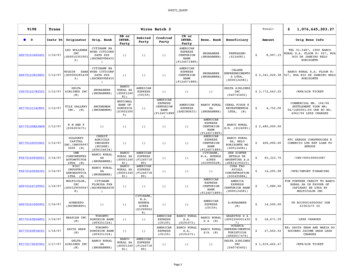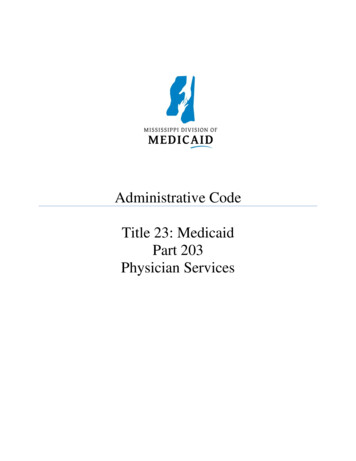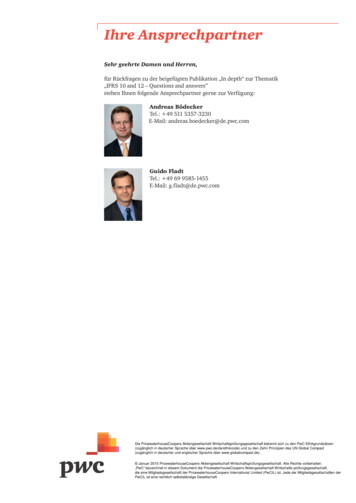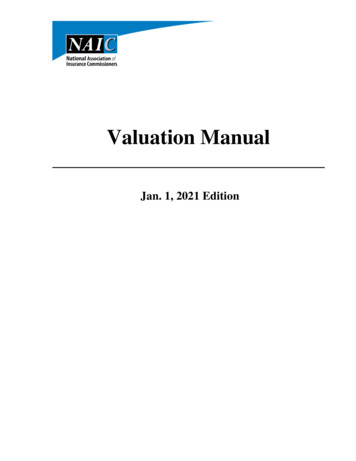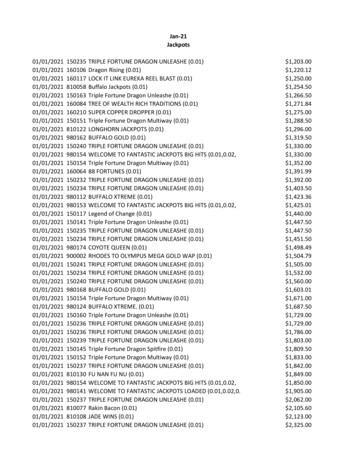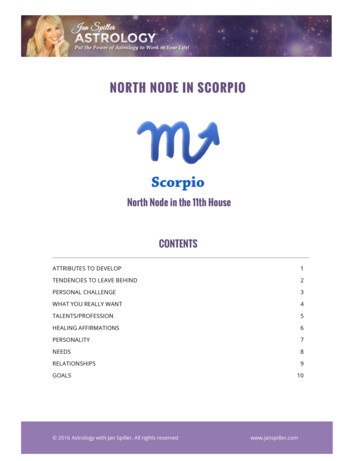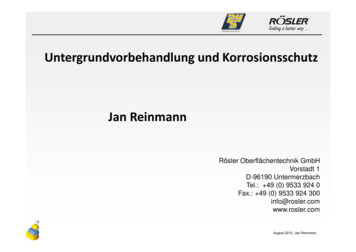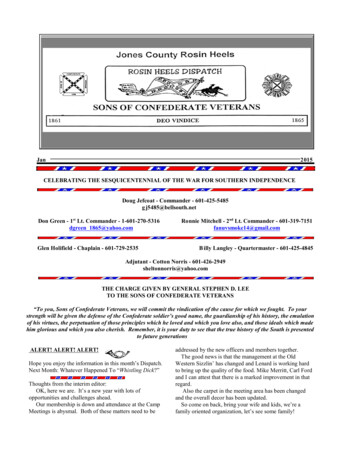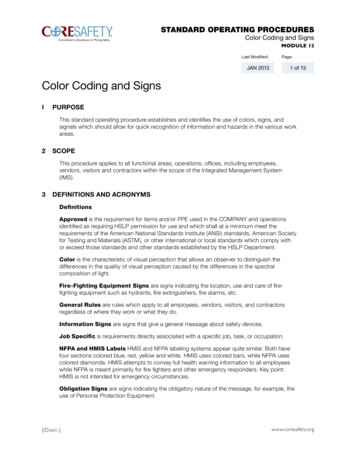
Transcription
Standard Operating ProceduresCommitted to Excellence in Mining SafetyColor Coding and SignsMODULE 12Last Modified:Page:JAN 20131 of 13Color Coding and SignsIPurposeThis standard operating procedure establishes and identifies the use of colors, signs, andsignals which should allow for quick recognition of information and hazards in the various workareas.2 SCOPEThis procedure applies to all functional areas, operations, offices, including employees,vendors, visitors and contractors within the scope of the Integrated Management System(IMS).3DEFINITIONS AND ACRONYMSDefinitionsApproved is the requirement for items and/or PPE used in the COMPANY and operationsidentified as requiring HSLP permission for use and which shall at a minimum meet therequirements of the American National Standards Institute (ANSI) standards, American Societyfor Testing and Materials (ASTM), or other international or local standards which comply withor exceed those standards and other standards established by the HSLP Department.Color is the characteristic of visual perception that allows an observer to distinguish thedifferences in the quality of visual perception caused by the differences in the spectralcomposition of light.Fire-Fighting Equipment Signs are signs indicating the location, use and care of firefighting equipment such as hydrants, fire extinguishers, fire alarms, etc.General Rules are rules which apply to all employees, vendors, visitors, and contractorsregardless of where they work or what they do.Information Signs are signs that give a general message about safety devices.Job Specific is requirements directly associated with a specific job, task, or occupation.NFPA and HMIS Labels HMIS and NFPA labeling systems appear quite similar. Both havefour sections colored blue, red, yellow and white. HMIS uses colored bars, while NFPA usescolored diamonds. HMIS attempts to convey full health warning information to all employeeswhile NFPA is meant primarily for fire fighters and other emergency responders. Key point:HMIS is not intended for emergency circumstances.Obligation Signs are signs indicating the obligatory nature of the message, for example, theuse of Personal Protection Equipment.(Cont.)www.coresafety.org
Last Modified:Committed to Excellence in Mining SafetyJAN 2013Page:2 of 13Overhead Power Transmission Line Information Signs are signs indicating whether ornot there is an electric hazard and the maximum height at which overhead power transmissionlines are located.Prohibition Signs are mandatory signs indicating not to do something.Site refers to any COMPANY location.Warning Signs are signs indicating the hazards and risks that must be taken into account.AcronymsANSIAmerican National Standards InstituteDOTDepartment of TransportationASTMAmerican Society for Testing and MaterialsHMRHSLP Management RepresentativeHSLPHealth, Safety and Loss PreventionIMSIntegrated Management SystemISEAInternational Safety Equipment AssociationMSDSMaterial Safety Data SheetsNFPANational Fire Protection AssociationPPEPersonal Protective Equipment4 ROLES AND RESPONSIBILITIESDocument OwnerHMRResponsible Roles and Position-HoldersContractors/Vendors are businesses performing a service for the COMPANY. They areresponsible for ensuring their employees working on COMPANY sites have the required locksand tags as specified in this procedure and that their employees understand and comply withthe requirements as outlined in this procedure.Employees and Contracted Employees are employees in any position whetherCOMPANY or contracted employees working on any COMPANY site. They are responsible forcomplying with the requirements as outlined in this procedure and be familiar with the hazardsassociated with compressed gases.General Foreman can be a COMPANY employee or a contractor/vendor working ortraveling on any COMPANY site. They are required to approve the Color Coding & Signs andensure it is correctly completed, inspect the work area prior to work commencing, and ensurethe necessary resources exist and are in place before any of the work is performed.(Cont.) Color Coding and Signswww.coresafety.orgMODULE 12
Last Modified:Committed to Excellence in Mining SafetyPage:JAN 20133 of 13HSLP is any COMPANY employee working under and including the Regional Director ofHSLP. They are responsible for establishing the minimum requirements for compressed gasessafety and periodically auditing for compliance to this procedure.Supervisor/Foreman or Designee can be a COMPANY employee or a contractor/vendorworking or traveling on any COMPANY site. They are responsible for training employees tothis procedure and for enforcement of all requirements, rules, and established guidelines asoutlined in this procedure.5DIRECTIONAll employees, vendors, contractors, and visitors traveling/working on site shall comply withand ensure personnel accountable to them comply with the following requirements of thisprocedure.SupervisorsEnsure that they and all workers under their responsibility are trained and know the meaning ofthe colors and signs in their respective areas.Be responsible for the strict compliance with this standard in their work areas.WorkersFollow guidelines of this standard.Do not damage signs and comply with the messages contained in them.GuidelinesSafety signs must be color coded as established in this standard.Safety signs must be posted in strategic spots and must be visible both day and night.Safety signs must be made of weather resistant materials.Safety signs must be kept clean and in good condition. In the event of wear and/ordiscoloration, signs must be removed and replaced immediately.Signs must be posted at prominent and strategic places.Workplace hazardsWork place hazards need to be marked to alert employees to the dangers that exist in afacility or area. Depending on the specific workplace situation, different regulations may apply.The Mine Safety and Health Administration (MSHA) requirements are often non-specific withregard to size, color and wording of markings. To provide uniformity, the American NationalStandards Institute (ANSI) has designed color schemes and sizes for marking hazards. Thecolor code identifies the type of hazard, which helps the employee identify the level of severity.It is meant to reduce the possibility of injuries. In areas where MSHA does not cite specificrequirements, the ANSI standard should be followed. The following chart represents the colorcodes of ANSI.(Cont.) Color Coding and Signswww.coresafety.orgMODULE 12
Last Modified:JAN 2013Committed to Excellence in Mining SafetyBackground ColorPage:4 of 13MeaningApplicationDangerSafety cans and signs.StopEmergency stop bar or button onmachinery. Identification of fireequipment.BiosafetyLabels and containers for bloodand infectious waste. (Warninglabels must be fluorescentorange or orange-red with thebiosafety symbol in a contrastingcolor.)CautionTripping, falling and strikinghazards.“Flammable, Keep Fire Away”labels on cabinets.Safety cans, containers forexplosives, corrosives orunstable materials.OrangeWarningParts of machinery or energizedequipment that may cut crushor otherwise injure. Inside oftransmission guards for pulleys,gears, etc.GreenSafetyLocation of first aid equipment.Location of safety equipment;respirators, safety showers, etc.BlueInformationSigns, bulletin boards.Specific railroad warningsagainst starting, using or movingequipment being repaired.Black, White, Yellow orCombination of Black withWhite or YellowBoundariesTraffic or housekeepingmarkings. Stairways, directionsand borders.Magenta or Purple onYellowRadiation CautionX-ray, alpha, beta, gamma,neutron and proton radiation.RedFluorescent Orange,Orange-RedYellow(Cont.) Color Coding and Signswww.coresafety.orgMODULE 12
Last Modified:Committed to Excellence in Mining SafetyPage:JAN 20135 of 13Labels and Other Forms of WarningLabels must be prominently displayed and legible. Missing or unreadable labels must bereplaced immediately.Containers containing hazardous chemicals must be labeled to include the followinginformation:a Identity of the hazardous chemical(s), which would permit cross-referencing betweenthe inventory list and the MSDS.b Appropriate hazard warning.c Required PPE.Label RequirementsHMIS labeling system is intended to be used by employers and workers on a daily basis andprovides information on acute and chronic health hazards, flammability, physical hazard, andpersonal protective equipment. The system helps the COMPANY comply with MSHA’s HazardCommunication Standard. HMIS emphasizes the use of personal protective equipment andhazard communication and shall be used for labeling of daily use containers that do not haveadequate labeling.NFPA’s labeling system is intended for use by emergency response personnel (fire fighters,hazardous materials workers, police, etc.) under emergency conditions. Labels containinformation on acute health hazards, flammability, physical hazard and special characteristicsthat may require special fire fighting techniques, such as reactivity with water. NFPA should beused for the labeling of buildings, bulk storage, tanks, bins, silos, etc.Secondary Container LabelingIf an employee transfers a hazardous chemical to another container, the individual performingthe transfer shall ensure that the secondary container is marked with the appropriate labelinginformation.Labeling Requirements for LabsLabs must comply with their respective Lab Labeling Requirements, and at minimum mustensure that the workers using hazardous chemicals:a Know the identity of the chemical, its hazards, any protective measures needed.b Leave the container empty at the end of the shift or ensure that it is properly labeled.(Cont.) Color Coding and Signswww.coresafety.orgMODULE 12
Last Modified:Page:JAN 2013Committed to Excellence in Mining Safety6 of 13Bulk Storage Tanks, Bins, and SilosLabeling of Bulk Storage Tanks, Bins, Silos, etc. should comply with NFPA 704 StandardSystem for the Identification of the Fire Hazards of Materials, which includes the NFPAdiamond (see below) AND the chemical name.Health hazard4Very short exposure could cause death or serious residual injury eventhough prompt medical attention was given.3Short exposure could cause serious temporary or residual injury eventhough prompt medical attention was given.2Intense or continued exposure could cause temporary incapacitation orpossible residual injury unless prompt medical attention is given.1Exposure could cause irritation but only minor residual injury even if notreatment is given.0Exposure under fire conditions would offer no hazard beyond that ofordinary combustible materials.Flammability(Cont.) Color Coding and Signs4Will rapidly or completely vaporize at normal pressure and temperature, or isreadily dispersed in air and will burn readily.3Liquids and solids that can be ignited under almost all ambient conditions.2Must be moderately heated or exposed to relatively high temperature beforeignition can occur.1Must be preheated before ignition can occur.0Materials that will not burn.www.coresafety.orgMODULE 12
Last Modified:JAN 2013Committed to Excellence in Mining SafetyPage:7 of 13Instability4Readily capable of detonation or of explosive decomposition or reaction atnormal temperatures and pressures.3Capable of detonation or explosive reaction, but requires a strong initiatingsource or must be heated under confinement before initiation, or reactsexplosively with water.2Normally unstable and readily undergo violent decomposition but do notdetonate. Also: may react violently with water or may form potentiallyexplosive mixtures with water.1Normally stable, but can become unstable at elevated temperatures andpressures or may react with water with some release of energy, but notviolently.0Normally stable, even under fire exposure conditions, and are not reactivewith water.Special HazardsThis section is used to denote special hazards. There are only two NFPA 704approved symbols:OXThis denotes an oxidizer, a chemical which can greatly increase the rate ofcombustion/fire.Unusual reactivity with water. This indicates a potential hazard using waterto fight a fire involving this material.(Cont.) Color Coding and Signswww.coresafety.orgMODULE 12
Last Modified:Committed to Excellence in Mining SafetyPage:JAN 20138 of 13Other symbols, abbreviations, and words that some organizations use in the white SpecialHazards section are shown below.These uses are not compliant with NFPA 704, they are presented here in case you see themon an MSDS or container label:ACIDThis denotes an oxidizer, a chemical which can greatly increase the rate of combustion/fire.ALKThis denotes an alkaline material, also called a base. These caustic materials have a pH greater than7.0CORThis denotes a material that is corrosive (it could be either an acid or a base).This is another symbol used for corrosive.The skull and crossbones are used to denote a poison or highly toxic material. See also: CHIPDanger symbols.The international symbol for radioactivity is used to denote radioactive hazards; radioactive materialsare extremely hazardous when inhaled.Indicates an explosive material. This symbol is somewhat redundantHMIS PPE CodesaSafety GlassesbSafety Glasses and GlovescSafety Glasses, Gloves and an AprondFace Shield, Gloves and an AproneSafety Glasses, Gloves and a Dust RespiratorfSafety Glasses, Gloves, an Apron, and a Dust RespiratorgSafety Glasses and a Vapor RespiratorhSplash Goggles, Gloves, an Apron, and a Vapor RespiratoriSafety Glasses, Gloves and a Dust/Vapor RespiratorjSplash Goggles, Gloves, an Apron, and a Dust/Vapor RespiratorkAirline Hood or Mask, Gloves, Full Suit and Bootsl–zCustom PPE Specified By Employer(Cont.) Color Coding and Signswww.coresafety.orgMODULE 12
Last Modified:Page:JAN 2013Committed to Excellence in Mining Safety9 of 13Pipe MarkingsUnmarked pipes mean danger – to both life and property. Numerous injuries have occurredthrough ign
the colors and signs in their respective areas. Be responsible for the strict compliance with this standard in their work areas. Workers Follow guidelines of this standard. Do not damage signs and comply with the messages contained in them. Guidelines Safety signs must be File Size: 952KBPage Count: 13People also search forcolor codes minecraft pcPLANTS MONTHLY COLOR CODEchemical color code chartcolor code for changing symbols on end mi where should oily rags be stored
